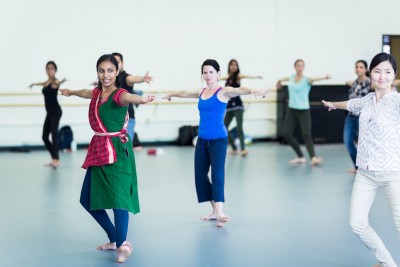
Speaking from the body
It’s Tuesday—aka a workday. I just got back from an hour-long walk through my happy neighborhood, Boise’s charming and slightly funky North End. I spent the next hour stretching, rolling out my body on a foam roller, then rolling on the floor, strengthening my cranky left foot, and working on body dynamics and balance.
No, I’m not on retreat. And yes, I consider this part of my job. Granted, I get to do more of this solitary physical work in the summers, when many of my regular clients are off having their own adventures. But the deeper I get into the practice of public speaking, the more I’ve realized how very physical it is. No surprise that at the TED Summit I attended in June, participants from around the world who are immersed in the world of public speaking flocked to workshops on physical skills. I took workshops on physical play, singing, and classical Indian dance (hence the picture).
In my view, speaking is the ultimate mind-body experience. As a speaker, your brain must be focused and engaged, always connected to both your audience and your ideas. But training your body is fundamental to speaking. Here’s why.
Your body is the vehicle by which you share your ideas—what’s in your head can only get into your audience’s heads by through the words you create with your mouth, face and voice (a physical act) and through by your body language, which almost always carries more weight than your words.
And then there’s the weird things your body can do when you speak. When you get nervous, or even just really focused on your talk, your body might not always behave like your friend. It can react to the rush of adrenalin and cortisol in ways that don’t make you happy: your hands feel exposed and awkward, you rock back and forth, and you feel like you can’t breathe.
So it makes sense that you want to understand this vehicle well—to master the instrument you’re using, so to speak. How exactly do you use your body to generate—then convey—passion? calm? reflection? action? To move your hand with conviction and grace, where does that gesture really come from: is it just your hand? your whole arm? your back? your core? or maybe it really starts with your feet?
If you have any doubts about how all your body parts are really connected, watch a dancer—or any Olympic athlete on TV in the coming days.
So yes, to really step into your role as a public speaker, you want to train your body with as care and attention as you prepare your mind and your talk itself. Here are a few principles to keep in mind:
1. It’s not about how you look—it’s awareness you’re after here. I’m not talking about weight loss or muscle definition. An internal sense of how your own body works is where you find ease and alignment and grace. Not to mention power.
2. It’s not about the kind of activity you do. Again, it’s about awareness. My favorite by far is Nia, an east-west fusion dance that incorporates a range of dance arts, martial arts and healing arts (from yoga to aikido, tai chi to Alexander technique). Dancing Nia over the past three-plus years has helped me more than any other form of movement to relieve chronic pain, understand and appreciate my body, and get over shyness about moving expressively. But whether you’re biking, walking or lifting weights, paying attention as you move is the most important thing.
3. Add variety to your routine by shifting your focus. In one Nia class we may focus just on our feet, exploring how they move and support weight. The next time we may focus on our hips. The next time it might be about shoulders or heads or fingers. That daily walk around the neighborhood can shift dramatically when you’re exploring the intricacies of different body parts or sensations each time.
4. Approach your physical training as research, without calling your performance “good” or “bad.” Discovering how stiff or weak a body part is (or how disconnected you are from it since you can’t even sense it!) is useful information. Gently explore what it’s connected to: how adjusting your hips might affect your back and neck and even your voice. Or how standing firmly on the ground, with your toes engaged like suction cups, affects your legs, your breathing, and your sense of confidence.
Most importantly, stick with it. Just like a dancer or an athlete or a construction worker, your body is indispensable to you as a speaker. The more you make friends with it, support it and understand it, the more it will help you own the stage with your ideas.
